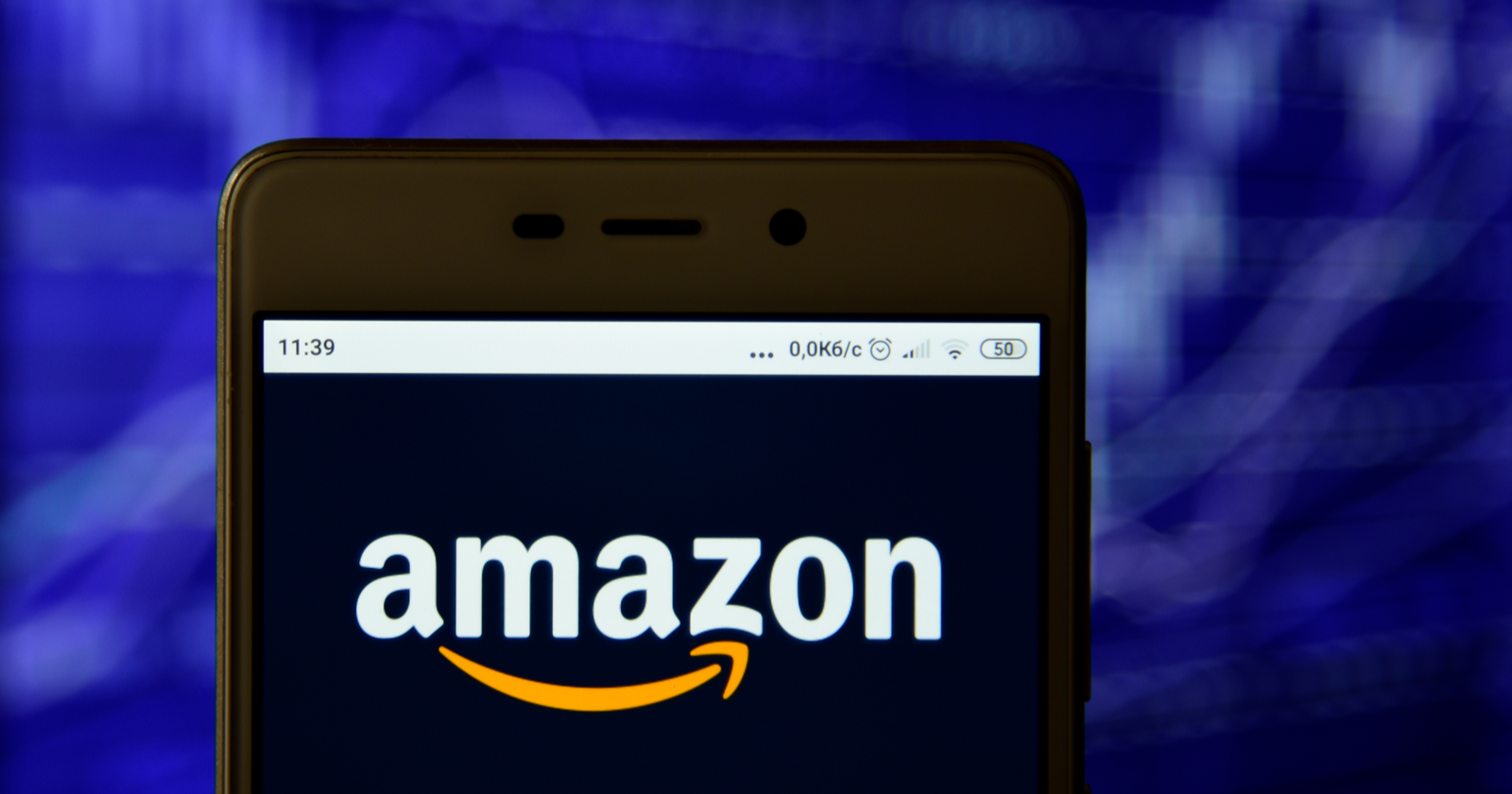It’s rare to be able to learn about a platform or technology from the way that the owner uses it.
Facebook doesn’t tell us how they optimize their Facebook ads. Though Google has begun to provide some insight into how it optimizes its web presence for search engines, no right-minded SEO professional is going to wholly rely on their advice.
Amazon is different.
Amazon sells a huge array of their own products on their marketplaces. This gives us an opportunity to learn about how they present those products and the tactics they deploy to optimize product listings.
What follows is a review of Amazon’s own listings covering Amazon products (e.g., Echo), Amazon-owned companies (e.g., Blink), and Amazon private label brands (e.g., Ella Moon clothing).
I’ve pulled out specific tactics from each content area that you will be able to use to improve your conversion rates and ultimately increase revenue.
We’ll look at the following areas:
- Product Titles
- Images
- Product Variations
- Bullet Points
- Enhanced Brand Content and A+ Content
I’ll show how Amazon:
- Adapts its presentation of content to suit the type of product and pricing.
- Knows when to communicate practical information and when to lean on emotional reasoning.
- Consistently address customer objections and highlights benefits.
- Utilizes additional sales features and optimization tactics to drive targeted, high-converting traffic.
Before we dive in, it’s worth emphasizing that simply copying what Amazon does is not a solid strategy.
Our aim should be to understand what they’re doing and why they’re doing it. Then apply those learnings to our situation.
If you’re new to Amazon then feel free to get in touch with me through the bio link at the end of this article.
What Is Amazon Conversion Rate Optimization & Why Is It so Fundamental to a Successful Amazon Strategy?
It’s vital to always bear in mind that Amazon is a point of sale. It becomes a great point of sale if the user can find the right product at the right price in the quickest possible time.
To create this seamless customer experience, Amazon needs to know which products are most likely to satisfy the customer’s needs.
This is where conversion rate comes in. If product A generates more orders per 100 visits than product B then, with everything else factored in, it is product A that will reap outsized benefits from Amazon’s algorithms.
A best-in-class conversion rate not only means your products will generate more sales from your current traffic levels but over time this will also boost your presence across Amazon’s search and promotional media space.
This creates a flywheel of more exposure, more traffic, more sales, more customer reviews, more brand awareness, and higher conversion rates.
This is why conversion rate optimization must be a priority for all Amazon sellers.
If you’re from an SEO background, think of it this way.
Just as Google views a relevant and authoritative backlink profile as fundamental to high website rankings, Amazon places the same value on products with high conversion rates.
A Higher Conversion Rate Gives Amazon Sellers Competitive Advantages
Let’s now delve into the specific advantages that high converting products derive from the Amazon ecosystem.
Organic Rankings
Much like Google, no one really knows exactly how Amazon’s A9 algorithm works but Amazon does provides some insight. Here’s the most pertinent section;
“Factors such as degree of text match, price, availability, selection, and sales history help determine where your product appears in a customer’s search results.”
I’ve highlighted ‘sales history’ because this is what we’re really interested in.
Sales history is a catch-all term for performance metrics such as order defect rate but what it really pertains to is how well the product converts.
In any reasonably competitive product vertical, sellers will have done the basics of including keywords, keeping products in stock, and pricing competitively.
Any ranking advantage is largely attributed to sales history and, specifically, conversion rate.
As Amazon itself states, search is the main way that people find products.
Despite the increasing dominance of ads in Amazon’s search results, organic rankings are integral to revenue growth.
Improve conversion rates and organic rankings will improve, too.
Bid Auctions
A higher conversion rate means a lower customer acquisition cost. It also provides a competitive advantage in sponsored ad bid auctions.
This isn’t specific to Amazon. We see the same idea represented by Google Ads’ Quality Score metric.
Here’s how it works.
For a given keyword and multiple competing product ads, Amazon will favor the ad for the product with the highest historic conversion rate even if the CPC bid is lower than that of competitors.
The reason is simple. Customer satisfaction overrides everything.
From the seller’s point of view, acquiring sales at a lower CPC means the budget is spent efficiently.
That saving can either be banked, reinvested into expanding the ad campaign, or diverted to other marketing activity.
Merchandising Exposure
An often overlooked benefit of a higher conversion rate is the huge organic exposure this creates within Amazon’s additional merchandising features.
Take a look on Amazon and consider just how many impressions appearing in each of these widgets can produce.
Best Sellers (A List of Best Sellers Within a Category)
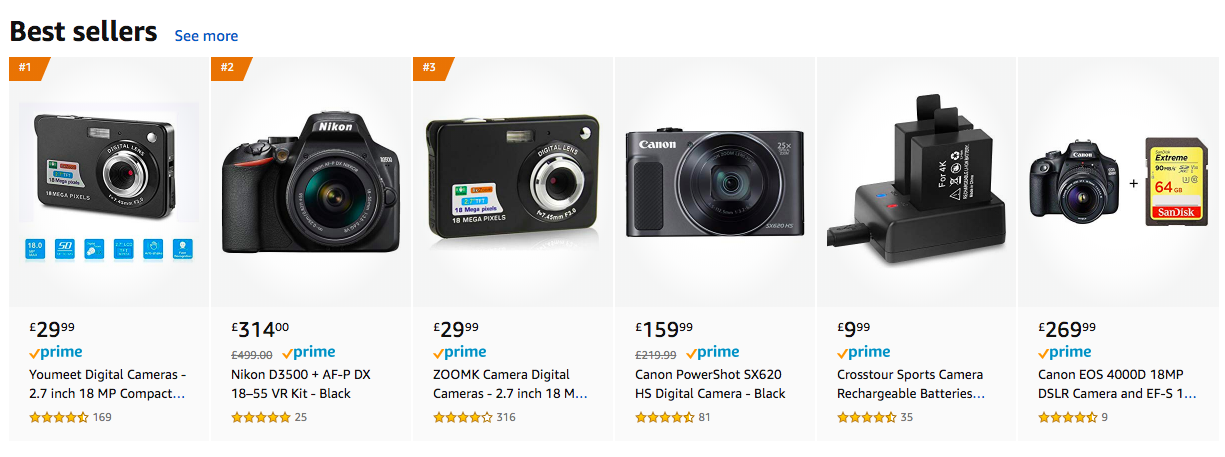
Customers Also Viewed/Shopped for Carousels

Compare with Similar Items (Product Comparison Tables)
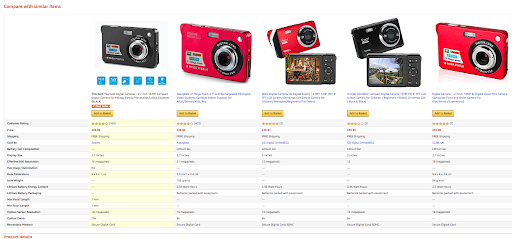
These spots are highly dynamic.
While it may seem that they favor products that have been on-sale for a long time, Amazon’s algorithm does factor in recent performance.
Making significant improvements to your conversion rate, increasing media spend, and tactical use of promotions can all contribute to increasing this exposure.
Non-Listing Conversion Optimization Strategies
It’s worth pointing out that, while we’re dealing specifically with listing optimization in this post, there are other factors that significantly influence conversion rate, namely:
- The delivery method (use FBA or Seller Fulfilled Prime).
- Price (the lower the better).
- Discounting.
For more information on these head to the following destinations:
- Seller Fulfilled Prime
- Fulfillment by Amazon (FBA)
- Pricing Strategy
- Discounting and Promotions
So, to quickly recap, we’ve learned:
- How integral conversion rate is to the Amazon ecosystem.
- The huge commercial advantages that can be gained from having competition-beating conversion rates.
Now, we’ll analyze each content element on a range of Amazon product listings to tease out the tactics they’re using to optimize their listings.
Product Title Optimization
Amazon provides very clear product title instructions. They even go to the extent of advising on the type of content that should be included.
For example, they suggest this format for small appliances
- Style: Brand + Model Number + Model Name + Product Type, Color
- Example: KitchenAid KSM150PSER Artisan 5-Quart Mixer, Empire Red
- Example: Vornado 510W Compact Air Circulato
Descriptive, keyword-rich titles are the best approach but that can mean different things for different products.
Example 1: Highlight Crucial Tech Specs

Emphasizing product compatibility is a classic sales tactic.
In this case, the charger is an accessory. Amazon knows that the first question people are going to ask is: “Have I found the right adaptor for my device?”
By addressing this straight-away they reassure users.
The title is also rich in keywords. By including device names, they are able to rank for ‘device + adaptor’ type keywords and ensure they’re attracting highly-motivated, high-converting visitors.
The phrase “Original OEM” might seem like an odd phrase to use but its included because Amazon knows there are a lot of cheap imitations.
OEM means “original equipment manufacturer”. The aim is to build trust that this is the real deal and a high-quality product.
One improvement I would make is to write this in layman’s terms (e.g., “Genuine Amazon Adaptor”). I didn’t promise that Amazon is perfect!
The wattage is included to reassure that people are buying the right version.
If you sell electronics, hardware or any other type of technical product, then be sure to include the most important technical specifications in your titles.
Example 2: Persuade with Key Product Attributes

A great title should be scannable, allowing the customer to pick out key benefits.
Here, Amazon’s Blink team highlights features such as high-quality recordings (HD Video), reliability, and low maintenance (“2-year Battery Life”).
Alongside the key benefits, Blink includes a key competitive advantage, namely cloud storage.
Example 3: Don’t Overcomplicate Titles

Sometimes simplicity is the best option.
This title tells you what it is, the color of the product, and that it’s the latest model.
Nothing more, nothing less.
This style isn’t going to be for everyone, but if your product doesn’t come in many variations and the customer isn’t prioritizing specific technical details then a simple approach can work.
Note that within Amazon’s website, the Echo faces very little competition so Amazon hasn’t overloaded the title with lots of keywords.
Improving Product Images
The image gallery is an opportunity to allow customers to explore the product in more detail. It should be used to provide context, such as:
- Who it is for.
- How it is used.
- How it works.
- What it comes with.
- How it looks in situ.
Example 4: Visualize Unique Features
One of the key selling points of the Amazon Echo (2nd Gen) is the multi-room feature.
Amazon has made a big play of how families can use one Echo to control other Echo devices.
The image reinforces this innovative feature.
Example 5: Counter Reasons Not to Buy
Overlaying images with text gives so much more context especially when it’s difficult to visualize the feature.
Amazon uses the text to reassure customers of the product quality.
It’s not a stretch to surmise that market research has shown that people may doubt that the Echo sound is as good as a traditional speaker system.
If your customer research shows that people are reticent to buy because of apprehension about specific features then use the images to address these concerns head-on.
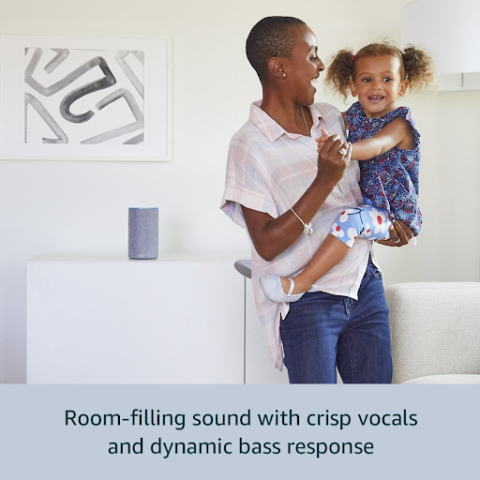 

The same tactic is used on the Blink camera system listing page. People may be concerned about exposing an electronic product to the weather so Amazon shows a wet camera.
The customer quickly understands the product is waterproof and that’s one less excuse not to buy.

Example 6: Highlight Product ‘Why-Buys’
There’s nothing particularly visual about the fire TV stick. What’s important is that it opens up a huge amount of TV and film content to the customer.
This is the core benefit.
Amazon uses the image to reinforce the range of accessible content (if you have Amazon Prime).
Consider what your core product benefit is and how that can be visualized. Place that in the first or second image slot to increase the customer’s exposure to this information.
Immediately hitting people with the strongest “why buy” and repeating this through the page is a great way of increasing the motivation to buy and increase your conversion rate.
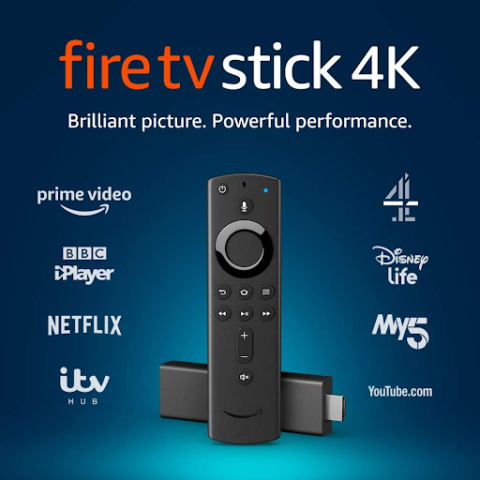
Smart Use of Product Variations and Selling Features
A simple yet often overlooked tenet of conversion rate optimization is that if you don’t offer the product the consumer wants then your conversion rates will be low.
The same applies if you have the right product but the consumer doesn’t know you sell it.
Example 7: Consolidate Variations to Reduce Customer Effort
This is why the correct use of Amazon’s product variation features is so important.
Here, not only is Amazon offering an incredible variety of colors, patterns, and sizes, but they’re also (not unsurprisingly) correctly using the parent-child relationship feature to full effect.
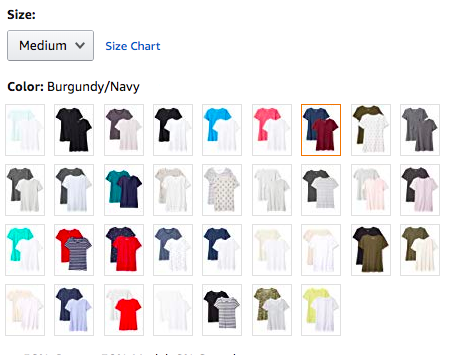
Often, Amazon sellers split their products on to separate listings. Doing so is a mistake precisely because you’re making it harder for the customer to find the right product.
By consolidating all product varieties onto one page, the customer is more likely to complete their purchase and, what do you know, higher conversion rates follow.
Example 8: Use Additional Selling Features to Build Confidence
This is a relatively new feature rolling out across the Amazon ecosystem. Everyone knows that DIY can be a frustrating experience.
If you’re not into that type of thing or you’re unfamiliar with installing electronic devices, then the idea of installing a $229 doorbell may well deter you from purchasing a Ring product.
Amazon offers an installation service to address this concern. That’s another excuse not to buy ticked off by the Amazon team.
Amazon offer a range of similar features for other types of products.
Product Listing Bullet Point Optimization
This is the most influential part of a listing page, as well as your best opportunity to sell the product and overcome any concerns that may stop a user from purchasing.
As Amazon advises, keep the copy concise and emphasize key benefits.
Think of the bullet points as a consultation with the customer. You’ve got a short time period and limited space.
The best bullet points are laser-focused on quick comprehension of the product and how it will benefit the user.
Example 9: Keep Copy Concise & Transactional
Another thing the Ring Video Doorbell listing does well is to educate the user and overcome concerns.
As a recent innovation, video doorbells provide a clear benefit but most people will be unfamiliar with how they work.
Amazon understands this.
It’s building up a persuasive argument by emphasizing benefits such as:
- Compatibility.
- Providing a free trial.
- The peace of mind that comes with real-time notifications.
 

The language is concise with a little flair.
Don’t underestimate the power of this approach. An Amazon user is highly motivated to purchase.
They’re likely to be far down the purchase funnel having already done some research and knowing exactly what type of product they need.
This transactional approach matches the user intent.
It’s fair to say that understanding intent is fundamentally important to achieving high conversion rates.
Example 10: Simple Products Don’t Need Embellishing
Don’t over-complicate the copy.
If you’re selling a simple, easy-to-understand product then just provide the necessary information.
Amazon isn’t trying to over-sell with flowery language and doesn’t feel obliged to use the full character count.
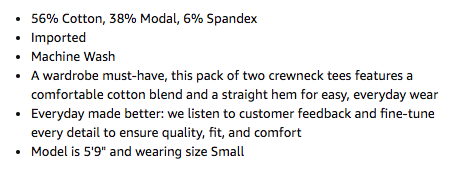 

Take these bullet points for a T-shirt set. The price is $18 so it’s not exactly designer clothing.
Amazon understands what the customer wants to know to be able to commit to the purchase.
- Easy to wash
- Size
- Suitable for everyday wear
Nothing more, nothing less.
Example 11: Emphasize Features of Functional Products
Selling a product is often about conveying the benefits – how will this product make you happier, healthier, wealthier, and so on.
Let’s be honest, not every product can make these types of claims. But no matter what you sell, your customer will always want to know if it’s the right product for their needs.
If you’re selling technical products, this invariably means providing specifications such as size, color, power ratings, and safety information.
 

Amazon doesn’t get distracted by trying to pitch this adaptor as anything other than a very functional item. There’s no attempt to show how it improves people’s lives.
If they were selling a higher ticket item that genuinely made life better, then absolutely the copy would promote benefits.
It’s all about knowing your product’s place in the world!
Enhanced Brand Content & A+ Content Storytelling
Many product listings will display a block of unformatted text mid-way down the page. This is the traditional product description.

Amazon advises to use this space to tell your brand’s story and, if appropriate, share important usage information such as ingredients, materials, settings, etc.
In a nutshell, use the space to educate the customer.
Due to the formatting limitations, many product descriptions end up looking like this. Pretty dull, right?
This is hardly going to contribute to a high conversion rate.
But, all is not lost.
If you are the brand or product owner, you are entitled to display what’s called Enhanced Brand Content (EBC). Brands selling through Vendor Central will have access to a similar service called A+ Content.
If you take a look at Amazon’s product listings, you’ll notice that the vast majority present a lot of visual information instead of this standard text description.
So what can we take from that?
Well, given the creative resources that are required to produce the content, EBC must strongly correlate with higher conversion rates, otherwise, Amazon wouldn’t display EBC/A+.
If you’re a Vendor account holder, then no doubt your Amazon account manager has encouraged you to invest in A+ content.
If you’re not a Vendor account holder then the secret is out!
Here’s how Amazon makes the most of Enhanced Brand Content.
Example 12: Communicate Core Value Proposition
Different sections of the page fulfill different jobs.
The top of Amazon’s listing pages tend to be highly functional and aimed at closing the transaction. The EBC content is designed to appeal to emotional purchase drivers.
Amazon takes the opportunity to tell a much richer, visual story.
In this case, the Fire TV Stick is pitched as a window into a cinema-quality world of entertainment all from the comfort of the home.
The value proposition is clear for all to see and leaves the customer in no doubt as to the excitement on offer.
While the copy is interspersed with functional information this is still consistent with key messaging around the quality of the experience.
Everything is tightly aligned towards this central entertainment message.
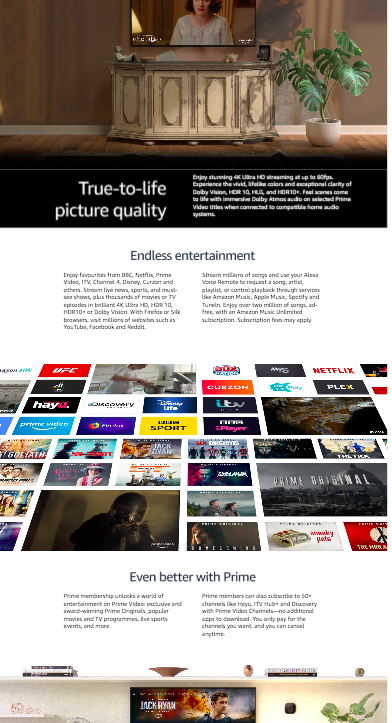
When creating your Enhanced Brand Content, think about the core message you want to convey.
Next, consider what emotions this should elicit in the buyer. The trick is to produce a visual format that reflects the sentiment you want to create.
Example 13: Use EBC Modules to Aid Decision-Making
Amazon provides a helpful comparison table within the EBC.
Here, they’re using it to simply display the differences across the Kindle range.
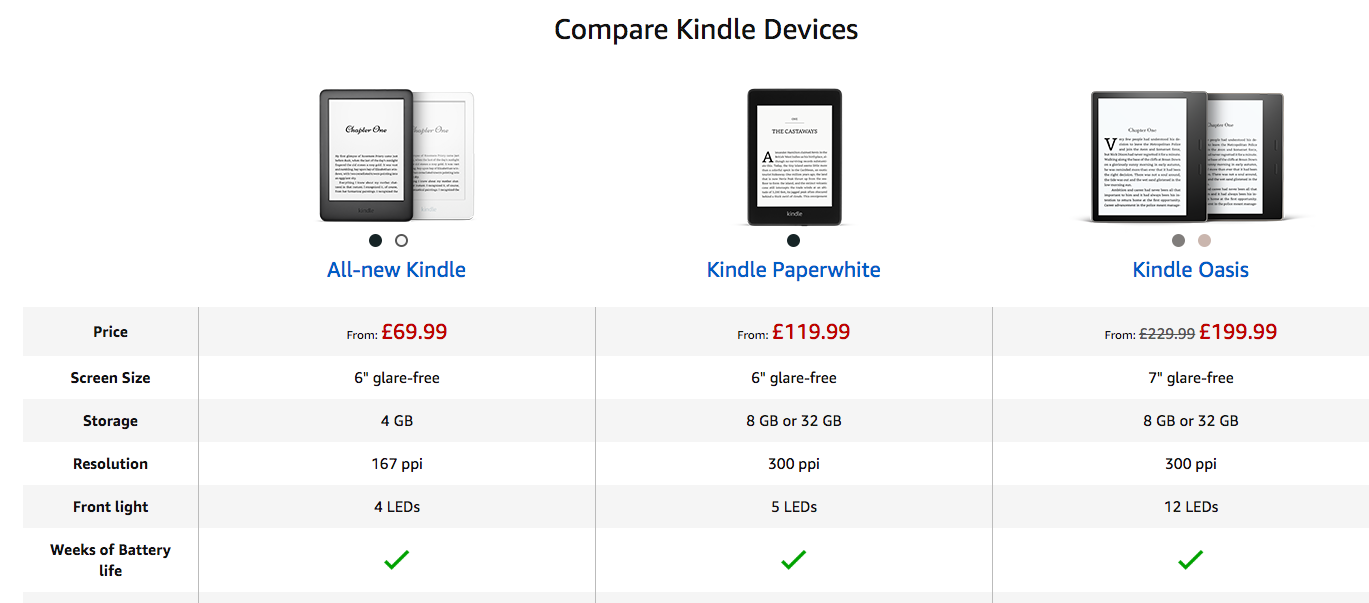
Comparison tables aren’t unique to Amazon’s websites. They allow users to research, compare and build confidence in their decision-making.
It’s this increased confidence that nudges a prospective purchaser into completing the transaction.
Remember that without EBC, it’s impossible to convey this type of information. This is why it’s crucial to deploy EBC if you’re conversion rates need a boost.
Example 14: Unfamiliar Brands Need to Communicate Their Story
Amazon is a huge global brand. It doesn’t waste any space by introducing who they are or what they stand for.
The opposite is true for Amazon’s private label stores.
Take this Ella Moon listing, for example. Very few people will have heard of the Elle Moon brand.
Instead of telling a product story as Amazon do with Echo, Fire TV Stick and other well-known products, this time the focus is on introducing the Ella Moon brand positioning.
If people are unfamiliar with your brand or your insights suggest your company story is a key conversion driver, then use the EBC to introduce your brand.
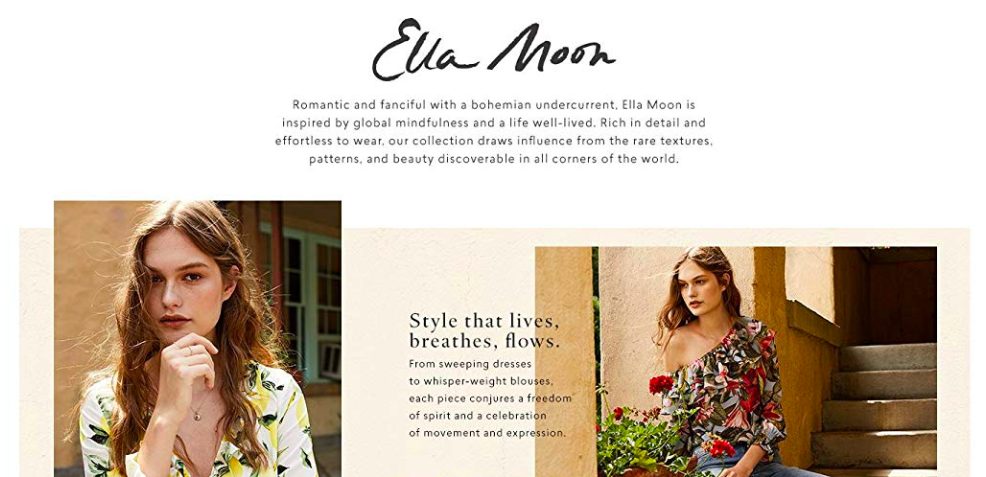
Try some of these classic brand communication tactics
- Heritage
- Credibility
- Trustworthiness
- Ethical principles
- Founder story (What motivated you to create the company and/or products?)
- Awards
- Testimonials
In Summary
So we’ve seen why conversion rates are fundamentally important and the virtuous circle of growth that products and brands enjoy when they achieve high conversion rates.
Amazon takes listing optimization seriously. Whether it’s a low priced T-shirt or a $229 doorbell, there’s attention to detail throughout each listing.
That doesn’t mean the same tactics, messaging and visual styles are deployed across each product.
It means that Amazon has understood the importance of:
- User intent.
- Core product benefits.
- When it’s appropriate to highlight features and technical information.
- When it’s best to play on emotional drivers.
We’ve also seen how Amazon has made the best use of each listing feature to reinforce key brand and product positioning.
Countering customer objections and emphasizing how each product meets the customer’s needs are crucial to producing high converting listings.
Take time to understand what these are for your products and how to best communicate those on the listing page.
Make the most out of features such as product variations and Enhanced Brand Content to present choices, comparisons, benefits, and specifications.
More Resources:
- Amazon Advertising: The 2019 Guide
- A Guide to Amazon Indexing & How to Check Your Keyword Indexing
- Amazon Advertising Options Guide: What Marketers Need to Know
Image Credits
All screenshots taken by author, July 2019

